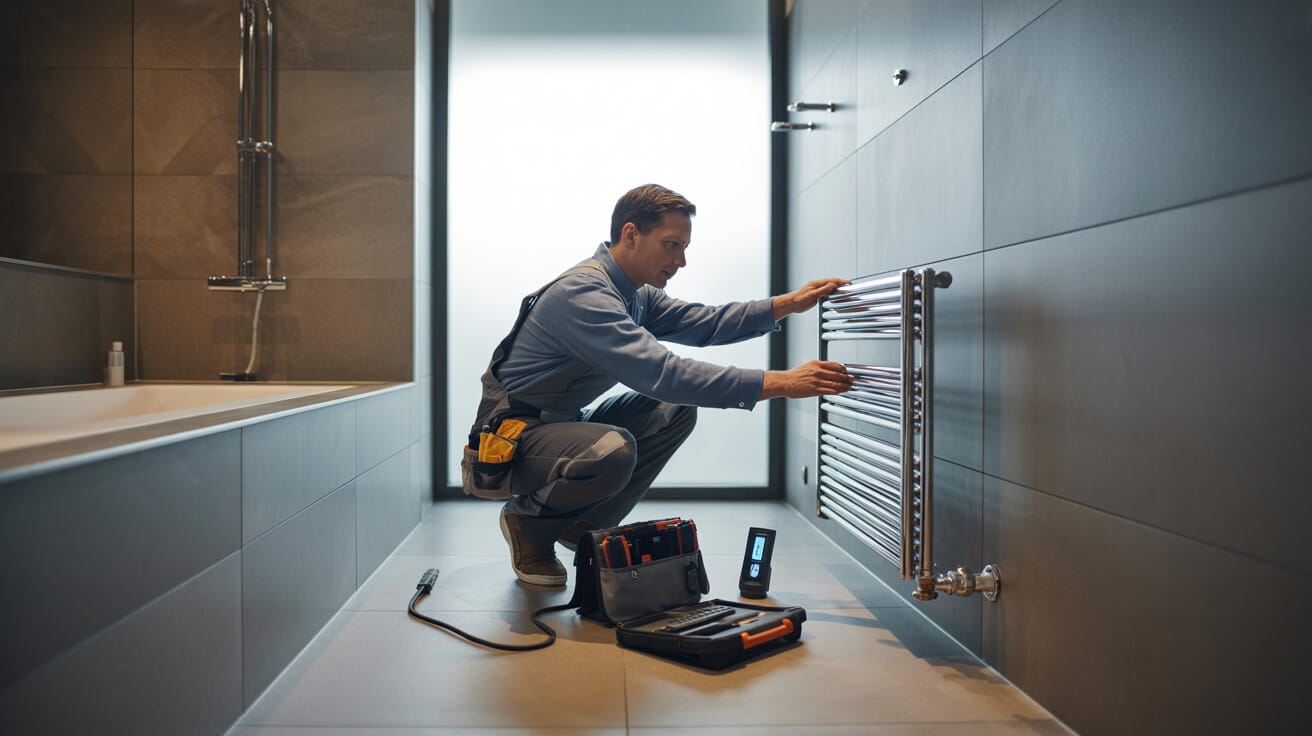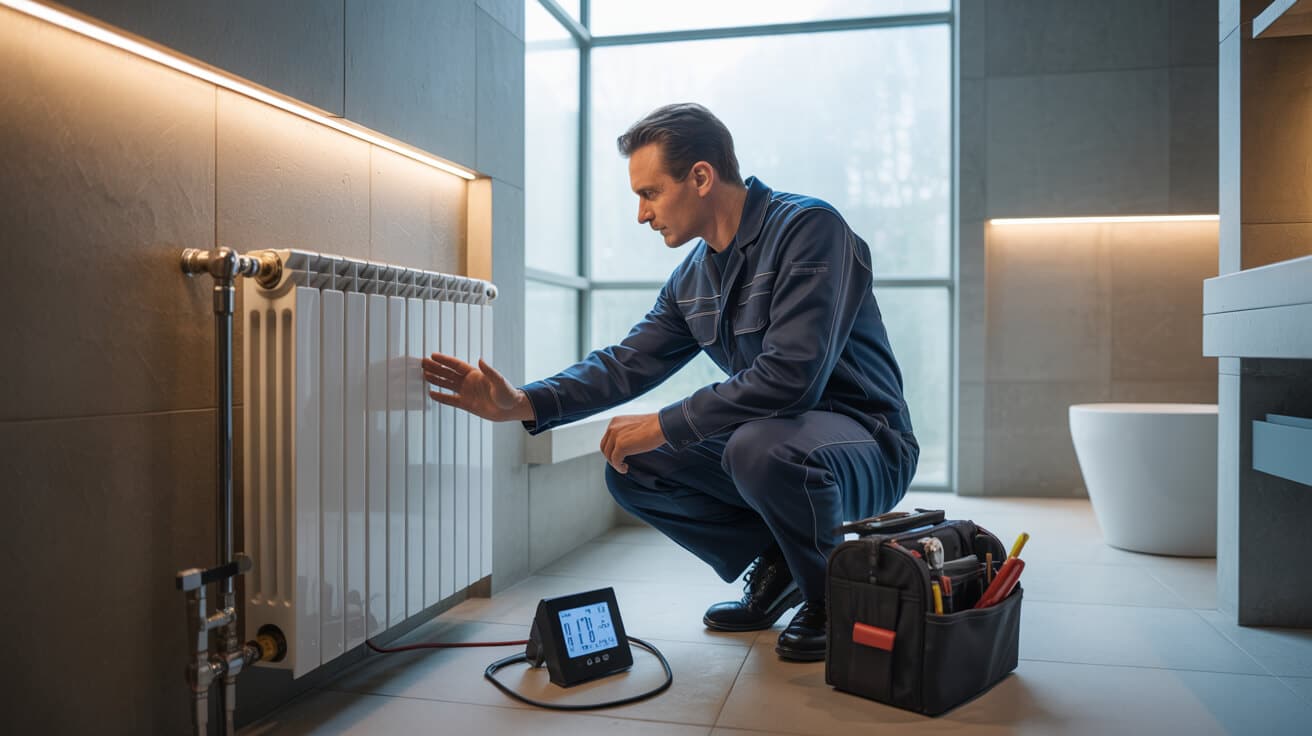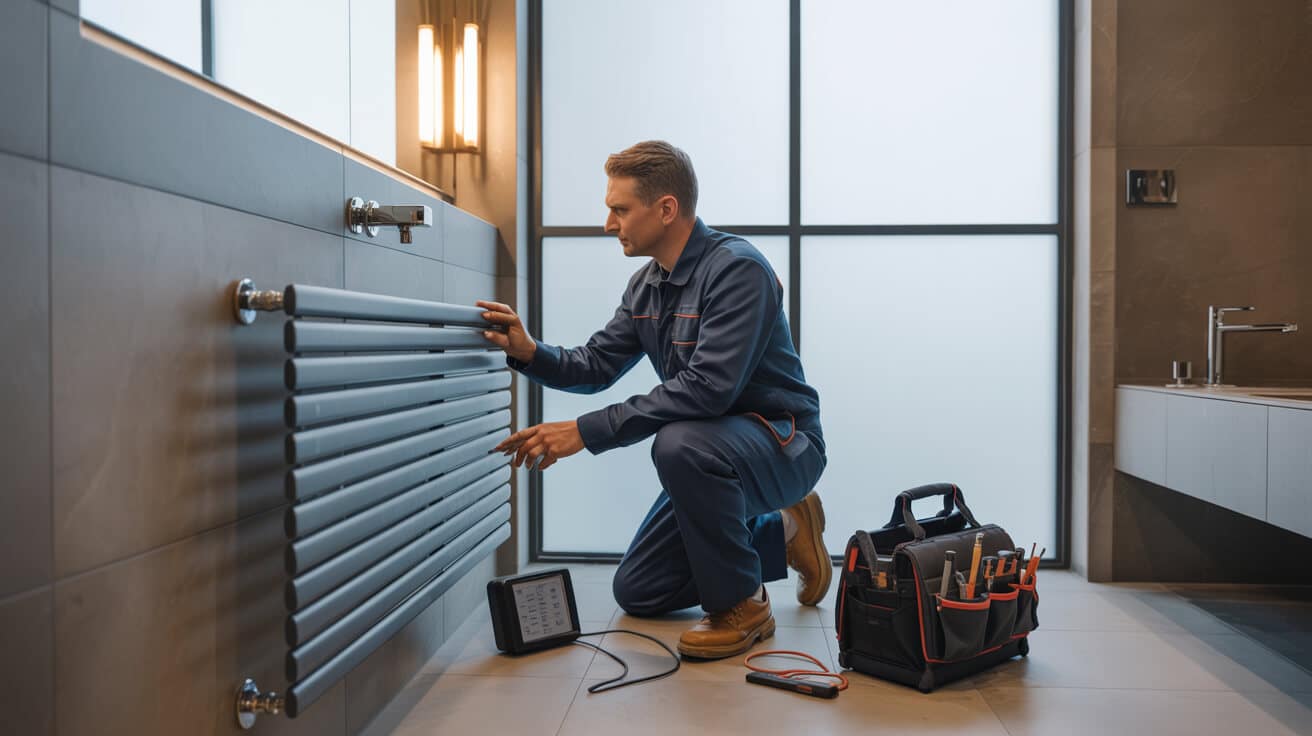Radiators are integral components of a centralised heating network, designed to transfer thermal energy from hot water to the circulating air. When a radiator remains cold, it not only disrupts the uniformity of room temperatures but also signals potential inefficiencies within the heating system. Factors such as the presence of airlocks, faulty thermostatic radiator valves (TRVs), sludge depositions, and systemic imbalances may contribute to this malfunction. Diagnosing and fixing the problem involves a combination of manual techniques, modern diagnostic tools, and adherence to industry standards. This article provides a detailed and neutral exploration of the methods employed to restore proper radiator function.
Etymology or Name Origin
The term “radiator” derives from the Latin word radius, meaning “ray” or “spoke,” reflecting the device’s function of radiating heat into a room. Over time, “cold radiator” has become a descriptor for a radiator that fails to emit sufficient heat. Historically, early heating systems utilised basic radiators that required manual adjustments, and the evolution of maintenance practices has led to the modern terminology used today in troubleshooting and repair contexts.
Overview / Context
Radiators function by transferring heat from hot water within a central circuit to the surrounding air, thereby warming the space. A cold radiator issue typically manifests when the heat output is below expected levels, leading to uneven room temperatures and increased energy consumption. This deficiency can occur for several reasons, including:
- Airlocks: Trapped air within the radiator reduces effective water circulation.
- Valve Malfunctions: Faulty thermostatic radiator valves hinder the proper regulation of hot water flow.
- Sludge or Scale Build‑Up: Accumulated impurities obstruct water flow and heat transfer.
- System Imbalance: Inconsistent water distribution across multiple radiators can reduce overall efficiency.
- Pump and Control Faults: Deficiencies in central pumps or miscalibrated control systems impair water circulation.
The context of a cold radiator fix extends beyond simply restoring heat; it encompasses the optimization of system performance, ensuring that the repair aligns with contemporary safety and efficiency standards such as those stipulated by regulatory bodies like WRAS and G3.
History
Radiator technology has experienced significant evolution from its inception to modern-day applications. Initially, simple cast-iron radiators served as the cornerstone of heating systems, providing basic heat distribution through passive design that required frequent manual intervention. As central heating systems advanced during the industrial era, radiators became more sophisticated, incorporating valves and automated controls to manage heat distribution with greater precision.
In the latter half of the twentieth century, heating systems underwent further refinement with the advent of digital controls and sensor-based diagnostics, ultimately leading to the development of modern repair methods. These innovations not only improved user comfort and energy efficiency but also established stringent regulatory frameworks. Today, the repair of a cold radiator is executed through a systematic approach that integrates advanced diagnostic techniques with traditional maintenance practices, ensuring compliance with rigorous industry standards.

Concept / Description
At its core, a cold radiator fix involves identifying and rectifying factors that prevent a radiator from achieving the required heat output. The common underlying causes include:
Airlocks
Air trapped within a radiator disrupts the flow of hot water, creating an insulating barrier that significantly reduces heat transfer. The standard remedy is bleeding the radiator—a process in which a tool is used to release the air, thereby restoring efficient water flow.
Thermostatic Radiator Valve (TRV) Malfunction
TRVs are central to regulating the amount of hot water entering a radiator. When these valves malfunction, the radiator may not receive the necessary water flow. This fault can result from mechanical wear or calibration errors, necessitating tests to gauge performance and, if needed, replacement or recalibration to ensure accurate heat regulation.
Sludge and Scale Build‑Up
Over time, mineral deposits and other contaminants accumulate within the radiator and its associated piping. This sludge or scale impedes the proper circulation and heat exchange processes. A common solution is a power flush—a process involving the circulation of chemicals designed to dissolve and remove these deposits, thus rejuvenating the radiator’s performance.
System Imbalance
System imbalances occur when the distribution of hot water is uneven across the heating circuit. Such imbalances may be a result of improperly adjusted balancing valves, malfunctioning pumps, or outdated system configurations. Correcting these imbalances involves recalibrating the system to ensure that each radiator receives an adequate and consistent amount of hot water.
Pump and Control System Issues
The pump and its control systems are responsible for maintaining the continuous circulation of hot water. Faults in these components can lead to reduced water flow, thereby causing radiators to remain cold. Diagnosing pump performance, adjusting settings, and recalibrating the broader control system are crucial steps in remedying these issues.
By methodically addressing these factors, technicians can implement a cold radiator fix that restores the heating system’s efficacy and ensures reliable, balanced warmth throughout a property.
Functionality / Purpose / Applications
The primary purpose of a cold radiator fix is to reinstate the optimal performance of a central heating system by correcting localised inefficiencies. The application process can be dissected into several key phases:
Diagnostic Procedures
- Radiator Bleeding:
This straightforward procedure involves using a bleed key to release air from the radiator. Restoring proper water circulation revitalises the radiator’s heat transfer capability.
- TRV Testing and Calibration:
Inspecting and, if required, recalibrating TRVs is critical. Effective valve operation ensures that radiators receive the appropriate hot water flow tailored to the room’s heating demands.
- Power Flushing:
When sludge or scale is present, power flushing is employed to cleanse the system. By circulating chemical solutions through the radiator and pipes, accumulated deposits are removed, thereby enhancing heat transfer.
- System Rebalancing:
In multi-zone or complex heating systems, ensuring uniform water distribution is essential. Adjusting balancing valves and pump settings can optimise water flow to each radiator.
- Control System Calibration:
Modern heating installations often include digital controls and smart thermostats. Recalibration of these systems ensures that they adequately respond to dynamic temperature changes and maintain consistent operation.
Practical Applications
- Energy Efficiency Improvement:
A restored radiator enhances energy conservation by ensuring optimal heat distribution, reducing the overall energy consumption of the heating system.
- Enhanced Comfort:
Effective repairs result in a more uniformly heated environment, eliminating cold spots and maintaining consistent indoor temperatures.
- Regulatory Compliance:
Adherence to industry standards, including those set by WRAS and G3, forms a fundamental part of the repair process, ensuring that any intervention is in line with current legal and safety requirements.
- Preventive Maintenance:
Regularly addressing radiator performance issues prevents more significant problems down the line, thereby extending the service life of the heating system and reducing emergency repair instances.
- Economic Advantages:
Efficient radiator function reduces energy bills and operational costs over time. Moreover, a reliably maintained heating system can enhance property values.
Service providers, such as Plumbers 4U, integrate these diagnostic and remedial procedures into their regular maintenance protocols. By combining manual expertise with modern automated diagnostic tools, professionals ensure that repairs not only resolve immediate issues but also bolster the long-term performance of the heating system.
Classifications / Types / Variants
Cold radiator faults can be classified based on the underlying cause as well as the specific repair techniques employed. These classifications help to streamline diagnostic procedures and select the most appropriate intervention:
- Air‑Related Issues:
Radiator bleeding is the primary intervention for issues resulting from trapped air. - Valve‑Related Issues:
This category focuses on diagnosing, recalibrating, or replacing TRVs that have malfunctioned. - Contaminant‑Related Issues:
Sludge or scale accumulation is addressed predominantly through methods such as power flushing and chemical descaling. - System Imbalance Issues:
These involve methodologies to rebalance the heating circuit, ensuring consistent water distribution across all radiators. - Control and Pump Deficiencies:
Diagnostics here focus on assessing central pump performance and recalibrating digital controls to ensure proper system operation.
Each classification provides a distinct pathway for the repair process, catering to the specific nature of the malfunction and guiding professionals toward the most effective repair strategy.
Systems / Tools / Methodologies
Diagnostic Tools
A suite of advanced tools and methodologies is used to diagnose and rectify cold radiator issues:
- Bleed Keys:
Used to release trapped air, a bleed key is critical for restoring water flow and heat transfer.
- Pressure Gauges:
These devices measure system pressure, identifying imbalances that may signal broader circulatory problems.
- Thermal Imaging Devices:
By visualising temperature differentials, thermal imagers help pinpoint cooler radiators or sections within a radiator that are underperforming.
- Acoustic Leak Detectors:
These are employed to detect subtle sounds indicative of hidden airlocks or leaks within the pipework.
- Test Pumps:
Used to simulate operating conditions, test pumps validate the efficacy of a repair by ensuring that radiators recirculate water properly.
Methodological Approaches
- Manual Inspection and Intervention:
Technicians conduct thorough visual inspections, followed by manual bleeding and physical tests. This approach is foundational in older or simpler systems.
- Automated Diagnostic Systems:
Modern heating systems often incorporate sensors that continuously monitor temperature, pressure, and flow rate. These systems provide real-time data that can preemptively diagnose a fault.
- Performance Comparisons:
By comparing system performance before and after an intervention, technicians can quantify improvements and verify that the repair has restored functionality.
- Standardised Repair Protocols:
Adhering to industry standards and regulatory guidelines (such as those by WRAS and G3) ensures that repairs are executed with a high degree of safety, quality, and consistency.
- Integrated System Calibration:
Digital control systems and smart thermostats are adjusted to align with the newly restored radiator performance, thereby ensuring overall system balance.
These systems and methodologies represent a convergence of traditional craftsmanship and modern technology, forming a robust framework for diagnosing and resolving radiator issues.

Stakeholders / Entities Involved
The process of fixing a cold radiator is often interdisciplinary and involves several key stakeholders:
- Plumbing and Heating Service Providers:
Professionals with the necessary qualifications and certifications, such as those provided by Plumbers 4U, who perform diagnostics, repairs, and maintenance.
- Regulatory Agencies:
Organisations such as WRAS, the Gas Safe Register, and CIPHE establish the guidelines and standards for safe and efficient repairs.
- Property Owners and Managers:
Homeowners, landlords, and commercial property managers rely on consistent heating performance, making it imperative that repairs are conducted reliably and efficiently.
- Technical Personnel and Engineers:
Their expertise is used to implement complex diagnostic procedures, calibrate control systems, and ensure that all repairs meet strict quality and safety benchmarks.
- Customer Representatives:
Transparent communication with clients ensures that they understand the repair process, the costs involved, and the long-term benefits of a properly maintained heating system.
The coordinated involvement of these stakeholders results in a more resilient and efficient heating infrastructure, benefiting both service providers and consumers.
Legal / Regulatory / Ethical Considerations
Repairing cold radiators must adhere to a strict regulatory framework to ensure safety and compliance within the plumbing and heating industry. Key considerations include:
- Regulatory Standards:
The repair process must align with national and regional standards, such as those established by WRAS and G3 certifications. Compliance with Building Regulations (e.g., Part G regarding hot water safety) is essential to ensure that all work meets safety benchmarks.
- Safety Certifications:
Certification processes such as CP12 for gas safety are critical in ensuring that work is performed by qualified professionals and adheres to legal requirements.
- Consumer Protection:
Transparent pricing, accurate diagnostics, and documented repair procedures are imperative to protect consumer interests. Ensuring that repairs do not compromise the heating system or introduce new hazards is a fundamental ethical requirement.
- Ethical Service Delivery:
Maintaining high-quality standards in every repair, providing honest assessments, and adhering to professional ethics are essential to build long-term trust between service providers and property owners.
- Quality Assurance Processes:
Routine performance testing and documented maintenance schedules help ensure that repairs are both effective and durable, reinforcing industry best practices.
These legal and ethical dimensions are critical not only for ensuring the safety and performance of heating systems but also for fostering trust and reliability in professional service delivery.
Performance Metrics / Data / Measurements
Evaluating a cold radiator fix involves a combination of qualitative assessments and quantitative measurements:
- Flow Rate Analysis:
Measuring the flow of water through the radiator before and after the fix helps determine whether airlocks or blockages have been successfully eliminated.
- Temperature Gradient Measurements:
Comparing temperature differentials across the radiator and its associated piping provides a clear indicator of restored heat distribution.
- Pressure Monitoring:
Continuous monitoring of system pressure ensures that the heating circuit operates within specified limits, thereby validating the success of rebalancing efforts.
- Energy Consumption Metrics:
Recorded changes in energy usage after a repair offer an indirect measure of improved efficiency—lower energy bills are an indicator of a more effective heating system.
- Thermal Imaging Results:
These results visually confirm the uniform distribution of heat post-repair.
- Service Reports:
Documented case studies and technician notes provide ancillary confirmation that particular interventions have led to measurable improvements.
By combining data from these methodologies, service providers can ensure that each repair not only addresses the immediate issue but also enhances the long-term performance of the heating system.
Challenges / Barriers / Limitations
Despite structured diagnostic and repair protocols, several challenges may impact the effectiveness of a cold radiator fix:
- Technical Limitations:
Hidden factors such as internal sludge accumulation or undetectable air pockets may complicate the diagnostic process. Older heating systems, in particular, may exhibit complex faults that resist standard procedures.
- Operational Barriers:
In systems with extensive multi-zone configurations, selectively addressing one radiator without affecting overall balance can be challenging. The differences in system design across properties demand tailored approaches that are not universally applicable.
- Economic Considerations:
The deployment of advanced diagnostic tools and comprehensive power flushing techniques can be cost-prohibitive. Balancing operational costs with potential energy savings is a significant concern.
- Accessibility Issues:
Radiators enclosed in difficult-to-access areas (e.g., behind furniture or within sealed spaces) complicate repair efforts. In some cases, invasive measures are required to perform a proper fix.
- Maintenance and Recurrence:
Without a robust regular maintenance programme, individual fixes may only offer temporary relief, leading to recurring cold radiator issues. Ensuring that repairs contribute to long-term system reliability remains an ongoing challenge.
- Variability of System Designs:
Differences between domestic, commercial, or industrial systems can necessitate varied diagnostic and repair methods. This variability often calls for custom solutions that align with unique system architectures.
Addressing these challenges requires a multifaceted approach that integrates both traditional and modern methodologies, ensuring that each repair adequately resolves the individual issue while contributing to the overall health of the heating system.
Impact / Influence / Legacy
Effective intervention in cold radiator faults has a pronounced impact on several fronts:
- System Performance:
Restoration of proper radiator function leads to improved heat distribution, which in turn enhances energy efficiency. This reduction in energy wastage not only lowers utility costs but also contributes to environmental sustainability.
- Occupant Comfort:
Adequate and uniform heating directly affects the comfort levels within a property. A well-maintained heating system minimises discomfort caused by cold spots and contributes to an overall stable indoor climate.
- Regulatory and Quality Standards:
Adhering to established regulatory frameworks (e.g., WRAS, G3, CP12) ensures that completed repairs meet stringent safety standards. This compliance reassures property owners and regulatory authorities alike, supporting industry-wide best practices.
- Economic Benefits:
In addition to reducing recurring repair costs, improved heating system performance directly correlates with lower energy bills. Over time, these savings can be substantial, further enhancing the value proposition for property owners and managers.
- Industry Best Practices:
Documenting and standardising repair methods help in the dissemination of knowledge across the plumbing and heating industries. These best practices form the foundation for professional training, continuous improvement, and the evolution of repair techniques.
- Legacy of Innovation:
Continual refinement of diagnostic and repair processes fosters an industry culture dedicated to innovation and quality. Over time, successful practices become a part of the industry’s legacy, influencing future generations of technicians and service providers.
Through these impacts, the systematic repair of cold radiators supports not only individual customer outcomes but also the broader reliability and advancement of heating systems as a whole.
Future directions, cultural relevance, and design discourse
Emerging trends and technological developments continue to shape the future landscape of radiator repair, promising more sophisticated and efficient solutions:
Technological Innovations
Advances in sensor technology and real-time data monitoring are poised to transform how cold radiator issues are diagnosed and resolved. Future diagnostic tools may incorporate more refined thermal imaging, advanced acoustic analysis, and machine learning algorithms capable of predicting faults before significant performance issues arise. These technologies promise to shift maintenance from a reactive to a proactive model, reducing downtime and preventing system breakdowns.
Sustainability and Energy Efficiency
The increasing focus on energy conservation and sustainable building practices is driving innovation in heating maintenance. Upcoming solutions may incorporate eco-friendly cleaning agents for power flushing and adopt materials that reduce energy losses. Enhanced efficiency not only

